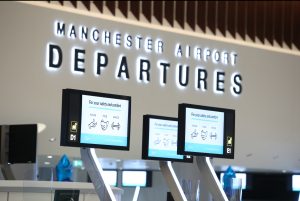£41m earmarked for improvements to Greater Manchester’s transport systems

More than £40m will be invested in Greater Manchester’s travel infrastructure, following a £23.7m injection by Active Travel England (ATE) announced today.
The region is spending a further £40.7m in its walking, wheeling and cycling infrastructure as it progresses with its delivery of the largest active travel network in the country.
ATE’s investment in Greater Manchester is the largest regional settlement in the UK.
In addition, the Greater Manchester Combined Authority (GMCA) is due to approve the release of £17m from the Mayor’s Challenge Fund for four major active travel schemes when leaders meet next week.
Both sources of investment will enable Greater Manchester to progress with its long term ambition to create the largest walking, wheeling and cycling network in the country, and further unlock the health and environmental benefits of active travel for people across the city-region.
Dame Sarah Storey, Greater Manchester’s Active Travel Commissioner, said: “The news of this funding award from Active Travel England is a sign of confidence in the plan we have here in Greater Manchester for the development of our Active Travel network. It’s vital that we are linking to the wider public transport system and building a Bee Network that provides genuine journey choice for residents and visitors alike.”
The £23.7m has been allocated to 13 schemes in total, including a new active travel corridor along Chapel Street in Salford and a striking cycling and walking ‘helix ramp’ as part of the new Stockport Interchange.
The eye-catching 180m spiral ramp will link a new rooftop park to the River Mersey and the TransPennine trail, and to a wider network of cycling, walking and wheeling routes. The ramp will not only be a striking structure to look at, but it will also provide a seamless and dedicated link for users to walk, wheel or cycle to the new park from ground level, and vice-versa.
The first phase of Salford’s Chapel Street East scheme, between New Bailey Street and Blackfriars, will make it easier and safer for people travelling on foot or by bike by providing high quality cycle lanes, as well as improved footways and crossing provision.
The other 11 schemes set to benefit from ATE’s award in Greater Manchester include:
- Parkhills Road/Heywood Street signalised junctions, Bury
- Radcliffe Metrolink Active access package, Bury
- Stockport East to Romiley Bee Network route, Stockport
- Ladybrook Valley Phase 2, Stockport
- Heatons Link Phase 2, including new crossings, Stockport
- Manchester Cycleway – ‘Yellow Brick Road’ improvements, Manchester
- Manchester Cycleway CYCLOPs junction at Wilmslow Road in Fallowfield, Manchester
- City Centre Bee Network: Islington, Salford
- Walking and wheeling facilities at signal junctions programme, GM-wide
- Cycle parking grant for public transport, GM-wide
- Cycle parking grant for schools and NHS sites, GM-wide
In addition to the ATE funding, GMCA leaders will also be asked to approve the draw down of a further £17m from the Mayor’s Challenge Fund at their next meeting on May 26, as part of the wider delivery of the Bee Network, Greater Manchester’s vision for an integrated London-style transport system.
Funding due to be rubber-stamped includes £4,312,386 for the Bee Network Crossings programme (GM-wide), £4,998,000 for improved active travel infrastructure in Bolton town centre east, a further £2,951,594 for the Lord Street-Rock Street scheme in Oldham town centre and £4,751,389 for three CYCLOPs junctions on Talbot Road in Trafford.
With approximately five million journeys made on Greater Manchester’s road network each day, the investment in active travel infrastructure will further enable people to opt for different modes of transport and in turn reduce congestion.
Andy Burnham, Mayor of Greater Manchester, said: “The scale of our ambition in transforming how people get around is huge, with a target for one million extra journeys being made on public transport or by bike or foot every day by 2040.
“To meet this challenge head on we are delivering our transformational Bee Network, which will make travelling easier, cheaper and more accessible and connect our trams and buses – and ultimately local train services – with the largest cycling, walking and wheeling network anywhere in the UK.
“It is great news that all 10 of our boroughs will benefit from more than £40m being invested in active travel schemes across the city region.”
As well as funding to deliver new and improved cycling and walking routes, leaders at next week’s GMCA meeting will also be asked to approve the release of funds – allocated to the city region from the Government’s City Region Sustainable Transport Settlement (CRSTS) – to enable the ongoing development of plans for a range of transport projects, including a new train station at Golborne, a new quality bus route connecting Ashton and Stockport and the development of future rapid transit schemes.
Proposals to strengthen governance arrangements around the delivery of Greater Manchester’s transformational plans for public transport and active travel will also be discussed, with plans for a new Bee Network Committee – which would lead transport decision making at a regional level, taking greater ownership and responsibility for the integrated network – to replace the existing Greater Manchester Transport Committee.








